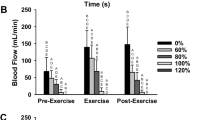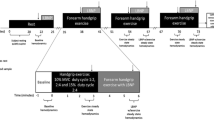Abstract
Phenylephrine increases mean arterial pressure (MAP) by enhanced total peripheral resistance (TPR) but near-infrared spectroscopy (NIRS) determined muscle oxygenation (SmO2) increases. We addressed that apparent paradox during supine rest and head-up tilt (HUT). Variables were determined ± phenylephrine in males during supine rest (n = 17) and 40° HUT (n = 7). MAP, stroke volume (SV), heart rate (HR), and TPR were derived by Modelflow® and NIRS determined biceps SmO2 and (tibial) bone oxygenation (StibialO2). For ten subjects, cardiac filling and the diameter of the inferior caval vein (ICV collapsibility index: ((ICVexpiration − ICVinspiration)/ICVexpiration) × 100) were assessed by ultrasound. Pancreatic polypeptide (PP) and atrial natriuretic peptide (proANP) in plasma were determined by immunoassay. Brachial artery blood flow was assessed by ultrasound and skin oxygenation (SskinO2) monitored by white light spectroscopy. Phenylephrine increased MAP by 34% and TPR (62%; P < 0.001) during supine rest. The ICV collapsibility index decreased (24%; P < 0.001) indicating augmented cardiac preload although volume of the left atrium and ventricle did not change. SV increased (18%; P < 0.001) as HR decreased (24%; P < 0.001). ProANP increased by 9% (P = 0.002) with unaffected PP. Brachial artery blood flow tended to decrease while SskinO2 together with StibialO2 decreased by 11% (P = 0.026) and 20% (P < 0.001), respectively. Conversely, phenylephrine increased SmO2 (9%) and restored the HUT elicited decrease in SmO2 (by 19%) along with SV (P = 0.02). Phenylephrine reduces skin and bone oxygenation and tends to reduce arm blood flow, suggesting that the increase in SmO2 reflects veno-constriction with consequent centralization of the blood volume.



Similar content being viewed by others
References
Murkin JM. Monitoring cerebral oxygenation. Can J Anaesth. 1994;41(11):1027–32.
Scheeren TW, Schober P, Schwarte LA. Monitoring tissue oxygenation by near infrared spectroscopy (NIRS): background and current applications. J Clin Monit Comput. 2012;26(4):279–87.
Madsen P, Olesen HL, Klokker M, Secher NH. Peripheral venous oxygen saturation during head-up tilt induced hypovolaemic shock in humans. Scand J Clin Lab Invest. 1993;53(4):411–6.
Sander-Jensen K, Secher NH, Astrup A, Christensen NJ, Giese J, Schwartz TW, Warberg J, Bie P. Hypotension induced by passive head-up tilt: endocrine and circulatory mechanisms. Am J Physiol. 1986;251(4):742–8.
Wallin BG, Sundlof G. Sympathetic outflow to muscles during vasovagal syncope. J Auton Nerv Syst. 1982;6(3):287–91.
Matzen S, Perko G, Groth S, Friedman DB, Secher NH. Blood volume distribution during head-up tilt induced central hypovolaemia in man. Clin Physiol. 1991;11(5):411–22.
Sander-Jensen K, Mehlsen J, Stadeager C, Christensen NJ, Fahrenkrug J, Schwartz TW, Warberg J, Bie P. Increase in vagal activity during hypotensive lower-body negative pressure in humans. Am J Physiol. 1988;255(1):149–56.
Sørensen H, Rasmussen P, Sato K, Persson S, Olesen ND, Nielsen HB, Olsen NV, Ogoh S, Secher NH. External carotid artery flow maintains near infrared spectroscopy-determined frontal lobe oxygenation during ephedrine administration. Br J Anaesth. 2014;113(3):452–8.
Poterman M, Vos JJ, Vereecke HE, Struys MM, Vanoverschelde H, Scheeren TW, Kalmar AF. Differential effects of phenylephrine and norepinephrine on peripheral tissue oxygenation during general anaesthesia: a randomised controlled trial. Eur J Anaesthesiol. 2015;32(8):571–80.
Sørensen H, Secher NH, Siebenmann C, Nielsen HB, Kohl-Bareis M, Lundby C, Rasmussen P. Cutaneous vasoconstriction affects near-infrared spectroscopy determined cerebral oxygen saturation during administration of norepinephrine. Anesthesiology. 2012;117(2):263–70.
Salisbury PF, Cross CE. Reflex effects of ventricular distention. Circ Res. 1960;8(3):530–4.
Mark AL, Abboud FM, Schmid PG, Heistad DD. Reflex vascular responses to left ventricular outflow obstruction and activation of ventricular baroreceptors in dogs. J Clin Invest. 1973;52(5):1147–53.
Mark AL, Kioschos JM, Abboud FM, Heistad DD, Schmid PG. Abnormal vascular responses to exercise in patients with aortic stenosis. J Clin Investig. 1973;52(5):1138–46.
Bogert LW, van Lieshout JJ. Non-invasive pulsatile arterial pressure and stroke volume changes from the human finger. Exp Physiol. 2005;90(4):437–46.
Suzuki S, Takasaki S, Ozaki T, Kobayashi Y. A tissue oxygenation monitor using NIR spatially resolved spectroscopy. Proc SPIE. 1999;3597(1):582–92.
Reisner SA, Lysyansky P, Agmon Y, Mutlak D, Lessick J, Friedman Z. Global longitudinal strain: a novel index of left ventricular systolic function. J Am Soc Echocardiogr. 2004;17(6):630–3.
Lang RM, Badano LP, Mor-Avi V, Afilalo J, Armstrong A, Ernande L, Flachskampf FA, Foster E, Goldstein SA, Kuznetsova T, Lancellotti P, Muraru D, Picard MH, Rietzschel ER, Rudski L, Spencer KT, Tsang W, Voigt JU. Recommendations for cardiac chamber quantification by echocardiography in adults: an update from the American society of echocardiography and the european association of cardiovascular imaging. Eur Heart J Cardiovasc Imaging. 2015;16(3):233–70.
Matzen S, Knigge U, Schutten HJ, Warberg J, Secher NH. Atrial natriuretic peptide during head-up tilt induced hypovolaemic shock in man. Acta Physiol Scand. 1990;140(2):161–6.
Schwartz TW, Holst JJ, Fahrenkrug J, Jensen SL, Nielsen OV, Rehfeld JF, de Muckadell OB, Stadil F. Vagal, cholinergic regulation of pancreatic polypeptide secretion. J Clin Invest. 1978;61(3):781–9.
Truijen J, Kim YS, Krediet CT, Stok WJ, Kolgen RS, Colier WN, Secher NH, van Lieshout JJ. Orthostatic leg blood volume changes assessed by near-infrared spectroscopy. Exp Physiol. 2012;97(3):353–61.
Davis SL, Fadel PJ, Cui J, Thomas GD, Crandall CG. Skin blood flow influences near-infrared spectroscopy-derived measurements of tissue oxygenation during heat stress. J Appl Physiol. 2006;100(1):221–4.
Daly Ide B, Verney EB. Localization of receptors involved in the reflex regulation of the heart rate. J Physiol. 1927;62(4):330–40.
Teboul J-L, Saugel B, Cecconi M, De Backer D, Hofer CK, Monnet X, Perel A, Pinsky MR, Reuter DA, Rhodes A, Squara P, Vincent J-L, Scheeren TW. Less invasive hemodynamic monitoring in critically ill patients. Intensive Care Med. 2016;42(9):1350–9.
Leone M, Blidi S, Antonini F, Meyssignac B, Bordon S, Garcin F, Charvet A, Blasco V, Albanese J, Martin C. Oxygen tissue saturation is lower in nonsurvivors than in survivors after early resuscitation of septic shock. Anesthesiology. 2009;111(2):366–71.
Claverias L, Marí M, Marín-Corral J, Magret M, Trefler S, Bodí M, García-España A, Yébenes JC, Pascual S, Gea J, Rodríguez A. The prognostic value of muscle regional oxygen saturation index in severe community-acquired pneumonia: a prospective observational study. J Intensive Care. 2016;4(1):1–9.
Jansen JR, Schreuder JJ, Mulier JP, Smith NT, Settels JJ, Wesseling KH. A comparison of cardiac output derived from the arterial pressure wave against thermodilution in cardiac surgery patients. Br J Anaesth. 2001;87(2):212–22.
Ji F, Li J, Fleming N, Rose D, Liu H. Reliability of a new 4th generation FloTrac algorithm to track cardiac output changes in patients receiving phenylephrine. J Clin Monit Comput. 2015;29(4):467–73.
Meng L, Tran NP, Alexander BS, Laning K, Chen G, Kain ZN, Cannesson M. The impact of phenylephrine, ephedrine, and increased preload on third-generation Vigileo-FloTrac and esophageal doppler cardiac output measurements. Anesth Analg. 2011;113(4):751–7.
Wood PW, Choy JB, Nanda NC, Becher H. Left ventricular ejection fraction and volumes: it depends on the imaging method. Echocardiography. 2013;31(1):87–100.
Ganio MS, Overgaard M, Seifert T, Secher NH, Johansson PI, Meyer MA, Crandall CG. Effect of heat stress on cardiac output and systemic vascular conductance during simulated hemorrhage to presyncope in young men. Am J Physiol Heart Circ Physiol. 2012;302(8):1756–61.
Bickler P, Feiner J, Rollins M, Meng L. Tissue oximetry and clinical outcomes. Anesth Analg 2016.
Nygren A, Thoren A, Ricksten SE. Vasopressors and intestinal mucosal perfusion after cardiac surgery: Norepinephrine vs. phenylephrine. Crit Care Med. 2006;34(3):722–9.
Acknowledgements
We are thankful for the effort made by the participating subjects.
Funding
The study was founded by a grant from Ehrenreich’s Fond (6000567).
Author information
Authors and Affiliations
Corresponding author
Ethics declarations
Conflict of interest
None.
Rights and permissions
About this article
Cite this article
Sørensen, H., Thomsen, J.H., Meyer, A.S.P. et al. Phenylephrine increases near-infrared spectroscopy determined muscle oxygenation in men. J Clin Monit Comput 31, 1159–1166 (2017). https://doi.org/10.1007/s10877-016-9965-y
Received:
Accepted:
Published:
Issue Date:
DOI: https://doi.org/10.1007/s10877-016-9965-y




